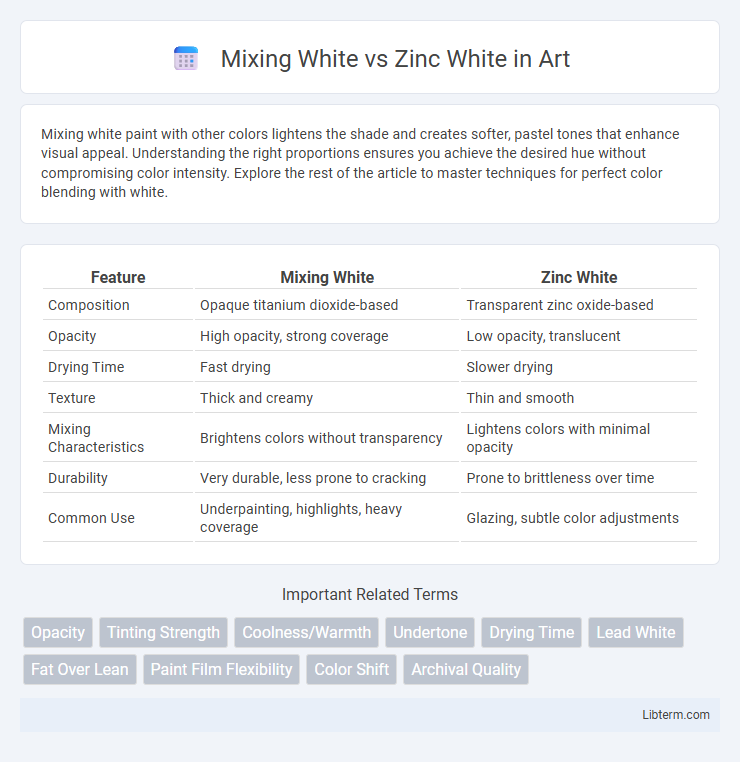Mixing white paint with other colors lightens the shade and creates softer, pastel tones that enhance visual appeal. Understanding the right proportions ensures you achieve the desired hue without compromising color intensity. Explore the rest of the article to master techniques for perfect color blending with white.
Table of Comparison
| Feature | Mixing White | Zinc White |
|---|---|---|
| Composition | Opaque titanium dioxide-based | Transparent zinc oxide-based |
| Opacity | High opacity, strong coverage | Low opacity, translucent |
| Drying Time | Fast drying | Slower drying |
| Texture | Thick and creamy | Thin and smooth |
| Mixing Characteristics | Brightens colors without transparency | Lightens colors with minimal opacity |
| Durability | Very durable, less prone to cracking | Prone to brittleness over time |
| Common Use | Underpainting, highlights, heavy coverage | Glazing, subtle color adjustments |
Understanding White Pigments: An Overview
Zinc White, composed primarily of zinc oxide, offers a cooler, less opaque tone compared to the warmer, denser Titanium White, commonly known as Mixing White. Artists prefer Zinc White for its transparency and subtle tinting strength, ideal for creating delicate highlights and glazing techniques without overpowering underlying colors. Understanding the distinct properties of these white pigments enhances color mixing precision and overall painting effects.
Composition of Mixing White vs Zinc White
Mixing White primarily consists of titanium dioxide combined with small amounts of zinc oxide, offering high opacity and excellent mixing properties. Zinc White is mainly zinc oxide, known for its transparency and slower drying time, making it ideal for glazing and mixing in oil paints. The compositional differences influence their opacity, drying speed, and color blending characteristics in artistic applications.
Opacity Differences: Mixing White and Zinc White
Mixing white pigments like Titanium White and Zinc White significantly affects paint opacity, as Titanium White offers higher opacity due to its larger particle size and stronger light scattering properties. Zinc White produces more transparent and cooler tones, making it ideal for subtle glazing and layering techniques where less coverage is desired. Artists often blend both to balance opacity and translucency, optimizing coverage while maintaining color vibrancy in their work.
Color Mixing Results: Impact on Paint Mixtures
Mixing White lead to softer, more transparent tints that retain color brightness, ideal for glazing and subtle shades. Zinc White produces cooler, more opaque mixtures with increased paint consistency and reduced yellowing over time. The choice between White and Zinc White significantly influences paint opacity, drying time, and final hue intensity in color mixing outcomes.
Drying Time and Paint Consistency Comparison
Zinc White dries slower than Mixing White, which contains a blend of whites designed for faster drying times suitable for quick layering techniques. Mixing White offers a smoother, creamier consistency that enhances paint flow and blending capabilities, whereas Zinc White is denser and stiffer, impacting the ease of application and brushstroke texture. Artists often prefer Mixing White for its balance between drying speed and paint consistency, while Zinc White is favored for details requiring opacity and durability despite its longer drying period.
Lightfastness and Longevity in Artwork
Zinc White offers superior lightfastness compared to traditional White, ensuring colors remain vibrant and resist yellowing over time. Mixing White typically contains more titanium dioxide, providing higher opacity but may compromise long-term durability when exposed to sunlight. Artists seeking longevity in their artwork often prefer Zinc White for its stable chemical structure that maintains color integrity in archival pieces.
Application Techniques for Each White
Mixing White offers a soft, opaque finish ideal for glazing and subtle layering techniques in oil and acrylic painting, allowing artists to preserve underlying colors while adding delicate highlights. Zinc White, characterized by its translucent quality and slower drying time, excels in impasto and detailed blending applications, providing a cooler, more neutral tone that minimizes yellowing over time. Mastery of each white's unique viscosity and opacity enables precise control of texture and luminosity, enhancing the dimensionality and depth of the artwork.
Best Uses in Various Painting Styles
Zinc white offers a cooler, more transparent hue ideal for glazing and detailed layering in realist or hyperrealist painting, maintaining luminosity without overpowering the palette. Mixing white provides a warmer, more opaque result favored in impasto techniques and expressive styles like Impressionism, where thicker, textured applications enhance movement and light. Artists selecting between mixing white and zinc white should consider drying time, opacity, and desired finish to match their specific painting style and method.
Mixing White and Zinc White with Other Colors
Mixing White and Zinc White with other colors creates distinct effects due to their different opacity levels and pigment compositions. Mixing White, typically Titanium White, produces vibrant, opaque pastels and tints that maintain strong color saturation, while Zinc White yields softer, more transparent hues with subtle cool undertones, ideal for delicate layering and glazing techniques. Artists often combine both whites to balance opacity and transparency, enhancing depth and luminosity in their color mixtures.
Choosing the Right White for Your Painting Needs
Choosing between Mixing White and Zinc White depends on the desired opacity and drying time for your painting. Mixing White offers high opacity and faster drying, making it ideal for bold, opaque highlights and base layers, while Zinc White provides greater transparency and slower drying, suitable for glazing and subtle light effects. Selecting the right white pigment enhances color vibrancy and texture, ensuring your artwork achieves the intended visual impact.
Mixing White Infographic

 libterm.com
libterm.com